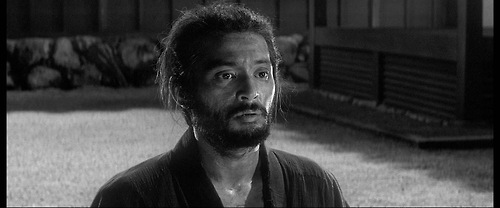-
HARA-KIRI: DEATH OF A SAMURAI (Takashi Miike 2011)
Takashi Miike: Hara-Kiri: Death of a Samurai (2011)

ICHIKAWA AS HANSHIRO TSUGUMO IN MIIKE'S HARA-KIRI
In this one, Miike doesn't stand up against Kobayashi
I'd been eager to see it when I first heard about it, but I missed Miike's 'Harakiri: Death of a Samurai' when it first came out, wasn't around for its brief theatrical release, somehow. Recently I rented it from Netflix, and then realized I should watch the 1962 version, which I had never seen and which Netflix also had. So I compared them, and consulted some of the numerous other comparisons that have been published. Frankly, why Miike chose to do this story when there was such a famous version of it already on film escapes me. The following I posted as an IMDb "Comment" on Miike's film, and there you will find a number of other comparisons of it with Kobayashi, mostly unfavorable for Miike. Nonetheless Miike's film has done well with US critics, getting a 76% Metacritic rating. But his 13 Assassins, with it's virtuoso fight sequences, got a Metacritic 87.
Anyone with a more than passing interest in Japanese movies ought to watch Kobayashi's 1962 version of Takaiguchi's novel that this also is based on, and watch the intro by the Japanese film authority Donald Ritchie on the Criterion edition. Ritchie makes fully clear how Kobayashi here, as in other films, is talking through the historical tale about current issues he was passionate about, in this case lingering post-WWII authoritarianism in Japan and hollow bureaucracies, in his day as in the time of the early Tokugawa government; Miike doesn't seem to have anything particularly urgent to say. Look at what Ritchie points out that Kobayashi's version offers: the script by ace screenwriter Shinobu Hashimoto who wrote the screenplay for Akira Kurosawa's Seven Samurai; the score by bold, influential experimentalist Toru Takemitsu (in contrast to Ryuichi Sakamoto's conventional music); the strong and unifying symbolic use of empty samurai armor throughout; the career-defining lead performance by Tatsuya Nakadai; and the elegantly austere use of black and white cinematography.
Ironically Miike's film also carries over Kobayashi's one serious flaw - - an overindulgence in sentimentality and pathos in the flashback love story -- and carries it to a truly crippling extreme.
Miike, apparently seeking 'respectability' after all his entertaining ultra-violence with this staid remake/adaptation, also overdoes everything. He makes every scene too drawn-out and talky. He further overdoes the sweetness and pathos to the point that in his version the flashbacks become unbearably cloying, ultimately unwatchable. Kobayashi's film is magnificent. Miike's verges on unwatchable. Same story: vastly different levels of artistry and taste.
Once again, 3D adds nothing; black and white was just what was needed. Less was and is more. Even admirers of Miike's film admit the 3D isn't used in a particularly effective way.
Whenever a filmmaker goes over familiar ground, adapting a book that has been adapted (and very well) before, he exposes himself to comparisons to the book and to the previous adaptation. Don't get me wrong. Miike has plenty of skill. It is not that his 'Hara- Kiri' is a washout. It's just that Kobayashi's version is a true work of art, a film classic, in fact; and in comparison Miike's is merely a competent effort and a pointless bid for respectability that was not needed. He is a master in his own realm. Surprisingly his last film before this, the juicy, action-historical blockbuster 13 Assassins, which I thoroughly enjoyed, also was an adaptation -- of Eiichi Kudo's little known samurai film of the same name. Thanks to 'Wildgrounds' (who compare the two Hara- Kiri films) for a reminder of this, and other points. Thanks also to Ben Parker on 'CapitalNewYork' for his detailed comparison of the two films; and to the Criterion Collection, for its print of Kobayashi's 'Hara-Kiri' and Donald Ritchie's informed introduction to it.
Hara-Kiri 3D: Death of a Samurai/Ichimei, 128 mins., debuted at Cannes 2011 in competition, first 3D film to do so; ten or so other international festivals; US theatrical release 20 July 2012. Kobayashi's Ichimei got the Jury Prize at Cannes in 1963. Miike's Cannes inclusion, his first at this level, was recognition of his prolific oeuvre, but Mike D'Angelo commented on AV Club that it "gets bogged down in an extended flashback that takes up the film’s entire midsection"; that while the '62 version's flashback "felt dramatically vital," here "it seems not just flaccid but superfluous, to the point where you wonder why it couldn’t have been condensed into a single line of dialogue." Kobayashi's version is even longer -- 133 minutes, but does not lose its momentum in the middle, and that makes all the difference.

NAKADAI AS TSUGUMO IN KOBAYASHI'S VERSION
Last edited by Chris Knipp; 06-26-2015 at 01:03 AM.
 Posting Permissions
Posting Permissions
- You may not post new threads
- You may not post replies
- You may not post attachments
- You may not edit your posts
-
Forum Rules






 Reply With Quote
Reply With Quote
Bookmarks